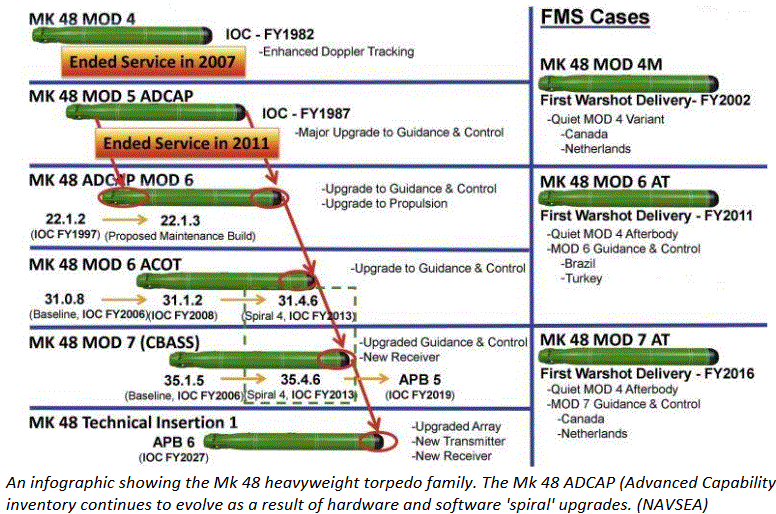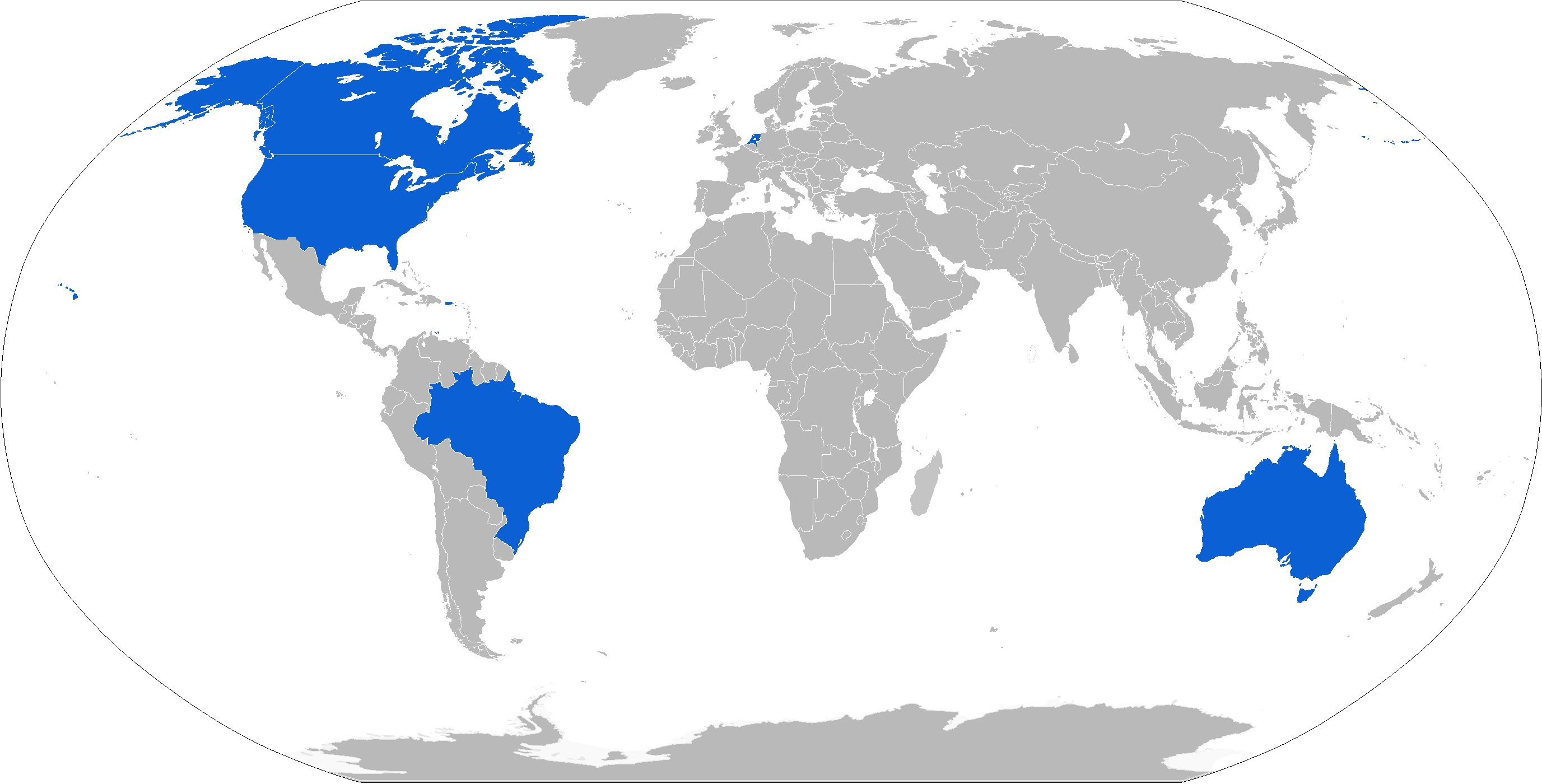MK 48 on:
[Wikipedia]
[Google]
[Amazon]
The Mark 48 and its improved Advanced Capability (ADCAP) variant are American heavyweight submarine-launched


Mk 48 at Raytheon CompanyUS Navy Fact File
{{DEFAULTSORT:Mark 48 Torpedo Cold War weapons of the United States Military equipment introduced in the 1970s Raytheon Company products Torpedoes of the United States
torpedo
A modern torpedo is an underwater ranged weapon launched above or below the water surface, self-propelled towards a target, and with an explosive warhead designed to detonate either on contact with or in proximity to the target. Historically, s ...
es. They were designed to sink deep-diving nuclear-powered
Nuclear power is the use of nuclear reactions to produce electricity. Nuclear power can be obtained from nuclear fission, nuclear decay and nuclear fusion reactions. Presently, the vast majority of electricity from nuclear power is produced b ...
submarines and high-performance surface ships.
History
The Mark 48 was initially developed as REsearch TORpedo Concept II (RETORC II), one of several weapons recommended for implementation byProject Nobska
Project Nobska was a 1956 summer study on anti-submarine warfare (ASW) for the United States Navy ordered by Chief of Naval Operations Admiral Arleigh Burke. It is also referred to as the Nobska Study, named for its location on Nobska Point nea ...
, a 1956 summer study on submarine warfare. The Mk-48 torpedo was designed at the end of the 1960s to keep up with the advances in Soviet
The Soviet Union,. officially the Union of Soviet Socialist Republics. (USSR),. was a transcontinental country that spanned much of Eurasia from 1922 to 1991. A flagship communist state, it was nominally a federal union of fifteen nation ...
submarine technology. Operational since 1972, it replaced the Mk-37, Mk-14 and Mk-16 torpedoes as the principal weapon of U.S. Navy submarines. With the entry into service of the new Soviet in 1977, the decision was made to accelerate the ADCAP program, which would bring significant modifications to the torpedo. Tests were run to ensure that the weapon could keep up with the developments and the weapon was modified with improved acoustics and electronics. The new version of the weapon, also known as Mk-48 Mod 4, was extensively tested and production started in 1985, with entry into service in 1988. From then on, various upgrades have been added to the torpedo. Mk-48 Mod 6 was in service; a Mod 7 version was test fired in 2008 in the Rim of Pacific Naval exercises. The inventory of the U.S. Navy
The United States Navy (USN) is the maritime service branch of the United States Armed Forces and one of the eight uniformed services of the United States. It is the largest and most powerful navy in the world, with the estimated tonnage o ...
in 2001 was 1,046 Mk-48 torpedoes. In 2017 Lockheed's production was approximately 50 per year.
Deployment
The Mk-48 torpedo is designed to be launched from submarine torpedo tubes. The weapon is carried by allU.S. Navy
The United States Navy (USN) is the maritime service branch of the United States Armed Forces and one of the eight uniformed services of the United States. It is the largest and most powerful navy in the world, with the estimated tonnage o ...
submarines, including ballistic missile submarines and -, -, and attack submarine
An attack submarine or hunter-killer submarine is a submarine specifically designed for the purpose of attacking and sinking other submarines, surface combatants and merchant vessels. In the Soviet and Russian navies they were and are called ...
s. It is also used on Canadian, Australian, and Dutch submarines. The Royal Navy
The Royal Navy (RN) is the United Kingdom's naval warfare force. Although warships were used by English and Scottish kings from the early medieval period, the first major maritime engagements were fought in the Hundred Years' War against ...
elected not to buy the Mark 48, preferring to use the Spearfish instead.
Mk-48 and Mk-48 ADCAP torpedoes can be guided from a submarine by wire
Overhead power cabling. The conductor consists of seven strands of steel (centre, high tensile strength), surrounded by four outer layers of aluminium (high conductivity). Sample diameter 40 mm
A wire is a flexible strand of metal.
Wire is c ...
s attached to the torpedo. They can also use their own active or passive
Passive may refer to:
* Passive voice, a grammatical voice common in many languages, see also Pseudopassive
* Passive language, a language from which an interpreter works
* Passivity (behavior), the condition of submitting to the influence of o ...
sensors to execute programmed target search, acquisition, and attack procedures. The torpedo is designed to detonate
Detonation () is a type of combustion involving a supersonic exothermic front accelerating through a medium that eventually drives a shock front propagating directly in front of it. Detonations propagate supersonically through shock waves with ...
under the keel
The keel is the bottom-most longitudinal structural element on a vessel. On some sailboats, it may have a hydrodynamic and counterbalancing purpose, as well. As the laying down of the keel is the initial step in the construction of a ship, in Br ...
of a surface ship, breaking the keel and destroying its structural integrity. In the event of a miss, it can circle back for another attempt.
Propulsion
The swashplate piston engine is fueled by Otto fuel II, amonopropellant
Monopropellants are propellants consisting of chemicals that release energy through exothermic chemical decomposition. The molecular bond energy of the monopropellant is released usually through use of a catalyst. This can be contrasted with bipro ...
which combusts to drive the engine. The thrust is generated by a propulsor assembly.
Sensors and improvements
The torpedo's seeker has an active electronically steered "pinger" (2D phased array sonar) that helps avoid having to maneuver as it approaches the target. Unconfirmed reports indicate that the torpedo's sensors can monitor surrounding electrical and magnetic fields. This may refer to the electromagnetic coils on the warhead (at least from 1977 to 1981), used to sense the metallic mass of the ship's hull and detonate at the proper stand-off distance. The torpedo has been the subject of continued improvement over its service lifetime. In the 1990s, a Mod 6 variant of the ADCAP provided much improvednoise
Noise is unwanted sound considered unpleasant, loud or disruptive to hearing. From a physics standpoint, there is no distinction between noise and desired sound, as both are vibrations through a medium, such as air or water. The difference aris ...
isolation for the engine, which makes this torpedo more difficult to detect for a potential target.
The Mk48 Mod 7 Common Broadband Advanced Sonar System (CBASS) torpedo is optimized for both the deep and littoral waters and has advanced counter-countermeasure capabilities. The MK48 ADCAP Mod 7 (CBASS) torpedo is the result of a Joint Development Program with the Royal Australian Navy and reached Initial Operational Capability in 2006. The modular Mod 7 variant increases sonar bandwidth, enabling it to transmit and receive pings over a wider frequency band, taking advantage of broadband signal processing techniques to greatly improve search, acquisition, and attack effectiveness. This version is much more resistant to enemy countermeasures.
On July 25, 2008 a MK 48 Mod 7 CBASS torpedo fired by an Australian , , successfully sank a test target during the Rim of the Pacific 2008 (RIMPAC
RIMPAC, the Rim of the Pacific Exercise, is the world's largest international maritime warfare exercise. RIMPAC is held biennially during June and July of even-numbered years from Honolulu, Hawaii, with the exception of 2020 where it was held ...
) exercises.
In 2015 the USN announced plans to restart production and seek a more modular design. Lockheed Martin is to upgrade existing Mark 48s to include a new guidance-control system known as the Common Broadband Advanced Sonar System (CBASS), in addition to improving propulsion and resistance to electronic countermeasures
An electronic countermeasure (ECM) is an electrical or electronic device designed to trick or deceive radar, sonar, or other detection systems, like infrared (IR) or lasers. It may be used both offensively and defensively to deny targeting info ...
.
Starting in 2003, the US Navy began the Stealth Torpedo Enhancement Program which aims to upgrade the capability of the existing Mk 48 design by implementing alternative fuel sources including electric fuel cells, and a "swim out" capability. The program is ongoing, with many details yet classified.

Operators

Current operators
* * * * *Future operator
*: in 2016 agreement was made to supply MK48 Mod6 AT toTaiwan
Taiwan, officially the Republic of China (ROC), is a country in East Asia, at the junction of the East and South China Seas in the northwestern Pacific Ocean, with the People's Republic of China (PRC) to the northwest, Japan to the nort ...
; in May 2020, 18 torpedoes were sold for $180 million.
See also
* American 21 inch torpedo *Baek Sang Eo (White Shark) torpedo
K731 Baek Sang Eo (White Shark) torpedo (Hangul: 백상어 어뢰) is a submarine-launched torpedo developed by the Republic of Korea Navy in 2004. Production was delayed for a year after a program error in the guidance system resulted in 2 fail ...
* Black Shark torpedo
* DM2A4
DM2A4 Seehecht (export designation "''SeaHake mod 4''" ) is the latest heavyweight torpedo developed by Atlas Elektronik for the German Navy, as a further update of DM2 (Deutsches Modell 2) torpedo which was released in 1976.
Description
Being ...
* F21 Artemis
* Futlyar
''Futlyar'' (''Fizik-2'') is a Russian deep-water homing torpedo tested by the Russian Navy in 2017; it entered service in the same year. Developed by the Saint Petersburg Research Institute of Marine Engineering and produced by the Dagdizel Mach ...
* Spearfish torpedo
* Tigerfish torpedo
The Mark 24 Tigerfish was a heavyweight acoustic homing torpedo used by the Royal Navy (RN) during the 1980s and 90s. Conceptual development dates to the mid-1950s, and formally started in 1959 with a target introduction date in 1969. A lengthy d ...
* Torped 62
* Type 65 torpedo
The Type 65 is a torpedo manufactured in the Soviet Union/Russia. It was developed for use against US Navy aircraft carrier battle groups, as well as large merchant targets such as supertankers and advanced enemy submarines. It is now typically fi ...
* Type 89 torpedo
* Varunastra (torpedo)
* Yu-6 torpedo
References
External links
Mk 48 at Raytheon Company
{{DEFAULTSORT:Mark 48 Torpedo Cold War weapons of the United States Military equipment introduced in the 1970s Raytheon Company products Torpedoes of the United States